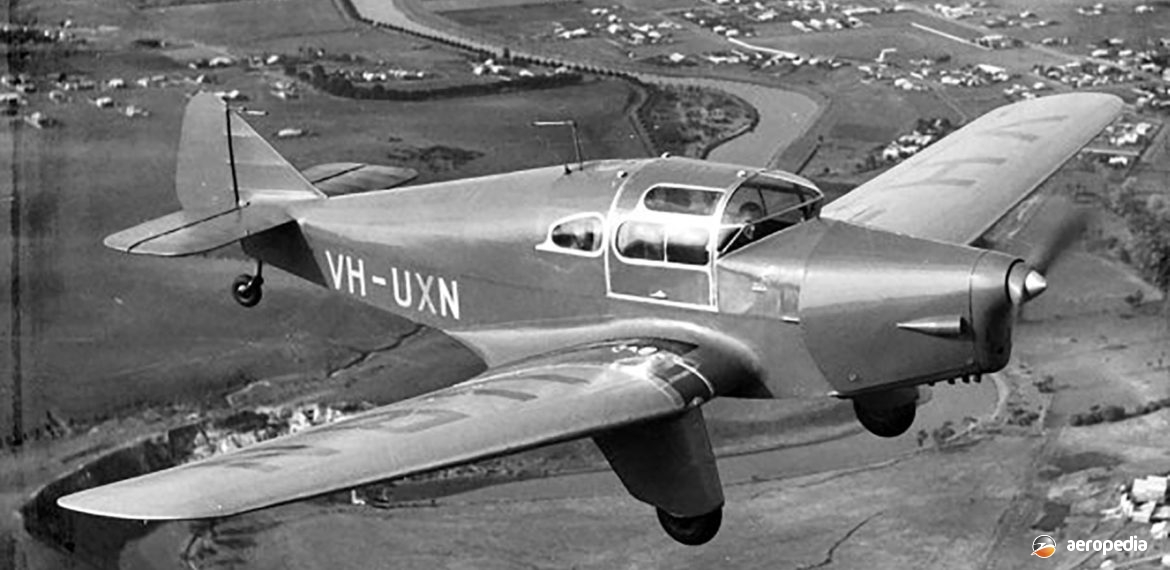Photograph:
Miles Merlin VH-UXN (c/n 272) over Melbourne, VIC in the 1930s (Eddie Coates Collection)
Country of origin:
United Kingdom
Description:
Light touring cabin monoplane
Power Plant:
one 149 kw (200 hp) de Havilland Gipsy Six six-cylinder in-line air-cooled engine
Specifications:
- Wingspan: 11.27 m (37 ft)
- Length: 7.89 m (25 ft 10 in)
- Height: 2.31 m (7 ft 5½ in)
- Wing area: 18.20 m² (196 sq ft)
- Max speed: 249 km/h (155 mph)
- Cruising speed: 225 km/h (140 mph)
- Initial rate of climb: 274 m/min (900 ft/min)
- Service ceiling: 5,490 m (18,000 ft)
- Range: 1,130 km (700 miles)
- Empty weight: 771 kg (1,700 lb)
- Loaded weight: 1,361 kg (3,000 lb)
History:
The Miles M.4A Merlin was an enlarged development of the Miles M.3 Falcon series designed to accommodate a pilot and four passengers. With a cabin 2.04-m (6 ft 7 in) long and 1.25 m (4 ft 1 in) wide, it was built to meet the requirements of Birkett Air Services Ltd, a charter operator based at Heston, UK, and Tata Airlines of Bombay, a small Indian airline. The prototype G-ADFE (c/n 151) was completed in 1935 and test flown at Woodley by F G Miles with the British test registration U-8 on 11 May 1938. This machine was flown all over Europe by its owners, Birkett Air Services, successfully, and charter flights were made with members of the press to various areas, including the war in Abyssinia in 1935 – 1936. It survived to 1939 but its ultimate fate is not known. It is believed it could have been destroyed in a German bombing raid on Britain in 1940, or was lost during the German invasion of France and the low countries in 1939.
Three other Merlins were built and, like the prototype, were designated M.4A, the M.4 designation being for a model with the Ratier variable pitch propeller which, in the event, was not available, so no M.4s were completed. Two examples VT-AGP (c/n 141 and VT-AHC (c/n 274) were supplied to Tata Airlines in India and operated between Karachi and Madras.
The fourth aircraft VH-UXN (c/n 272) was imported to Australia in June 1936 for Captain Eric Chaseling, a well-known 1930s aviator with Roberts Airways. After arrival it was assembled at Essendon, VIC and test flown on 19 June 1936. It was registered to Roberts Airways Pty Ltd and is reported to have carried the registration VH-UBN for a period until this registration was corrected [VH-UBN had been allocated to a de Havilland DH.89 Dragon Rapide]. The photograph above taken at the time shows the aircraft with VH-UXN on the fuselage but with the registration VH-UBN on the wings.
Named Wilgul it operated services between Melbourne, VIC and Hay, NSW, making a stop at Deniliquin, NSW on the way. Ownership was changed to Victorian & Interstate Airways Ltd. On 23 November 1940 it was impressed by the RAAF for war service (as A37-2) and was issued to No 1 Aircraft Depot and then to No 1 Conversion Flight. For a period around August 1941 it operated from Pearce, WA and saw service for the period of the war as a communications aircraft but, probably due to lack of spares, being the only example of the type in Australia, it was later converted to components and did not survive the war.

